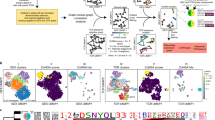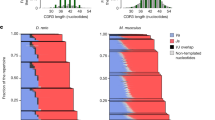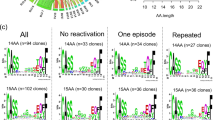Abstract
T lymphocytes recognize cell-bound antigens in the molecular context of the self major histocompatibility complex (MHC) gene products through the surface T-cell receptor(s). The minimal component of the T-cell receptor is a heterodimer composed of α and β subunits, each of relative molecular mass (Mr)∼ 45,000 (refs 1–3). Recently, complementary DNA clones encoding these sub-units have been isolated and characterized along with that of a third subunit of unknown function, termed γ (refs 4–9). These studies revealed a primary structure for each subunit that was clearly similar to that of immunoglobulin and indicated a somatic rearrangement of corresponding genes that are also immunoglobulin-like. Recently, the analysis of the sequence organization of the T-cell receptor β-chain10–16 and T-cell-specific γ-chain gene families17 has been reported. We now present an initial characterization of the murine T-cell receptor α-chain gene family, and conclude that although it is clearly related to the gene families encoding immunoglobulins18, T-cell receptor β-chains10–16 and also T-cell γ-chains17, it shows unique characteristics. There is only a single constant (C) region gene segment, which is an exceptionally large distance (∼20–40 kilobases (kb) in the cases studied here) from joining (J) gene segments. In addition, the J cluster and the variable (V) segment number seem to be very large. Finally, in the case studied here, a complete α-chain gene shows no somatic mutation and can be assembled directly from Vα, Jα and Cα segments without inclusion of diversity (Dα) segments.
This is a preview of subscription content, access via your institution
Access options
Subscribe to this journal
Receive 51 print issues and online access
$199.00 per year
only $3.90 per issue
Buy this article
- Purchase on SpringerLink
- Instant access to full article PDF
Prices may be subject to local taxes which are calculated during checkout
Similar content being viewed by others
References
Allison, J. P., Mclntyre, B. W. & Bloch, D. J. Immun. 129, 2293–2300 (1982).
Haskins, K. et al. J. exp. Med. 157, 1149–1169 (1983).
Meuer, S. C. et al. J. exp. Med. 157, 705–719 (1983).
Hedrick, S. M. et al. Nature 308, 153–158 (1984).
Yanagi, Y. et al. Nature 308, 145–149 (1984).
Saito, H. et al. Nature 312, 36–39 (1984).
Chien, Y.-H. et al. Nature 312, 31–35 (1984).
Sim, G. K. et al. Nature 312, 771–775 (1984).
Saito, H. et al. Nature 309, 757–762 (1984).
Gascoigne, N. et al. Nature 310, 387–391 (1984).
Mallissen, M. et al. Cell 37, 1101–1110 (1984).
Chien, Y.-H. et al. Nature 309, 322–326 (1984).
Kavaler, J., Davis, M. M. & Chien, Y.-H. Nature 310, 421–423 (1984).
Siu, G. et al. Nature 311, 344–350 (1984).
Siu, G. et al. Cell 37, 393–401 (1984).
Sims, J. E., Tunnacliffe, A., Smith, W. J. & Rabbitts, T. H. Nature 312, 541–545 (1984).
Hayday, A. C. et al. Cell 40, 259–269 (1985).
Tonegawa, S. Nature 302, 575–581 (1983).
Kabat, E. A., Wu, T. T., Bilofsky, H., Reid-Miller, M. & Perry, H. US Dept Hlth hum. Serv. Publ. 80–2008 (1983).
Sakano, H. et al. Nature 277, 627–633 (1979).
Steinmetz, M. & Hood, L. Science 222, 727–733 (1983).
Sakano, H., Hüppi, K., Heinrich, G. & Tonegawa, S. Nature 280, 288–294 (1979).
Sakano, H., Maki, R., Kurasawa, Y., Roeder, W. & Tonegawa, S. Nature 286, 676–683 (1980).
Early, P. et al. Cell 19, 981–992 (1980).
Tonegawa, S. et al. Cold Spring Harb. Symp. quant. Biol. 40, 839–857 (1981).
Max, E. E., Seidman, J. G. & Leder, P. Proc. natn. Acad. Sci. U.S.A. 76, 3450–3454 (1979).
Gehring, W. J. Cell 40, 3–5 (1985).
Sakano, H., Kurosawa, Y., Weigert, M. & Tonegawa, S. Nature 290, 562–565 (1981).
Kurosawa, Y. et al. Nature 290, 565–570 (1981).
Augustin, A. & Sim, G. K. Cell 39, 5–12 (1984).
Jerne, N. K. Eur. J. Immun. 1, 1–9 (1971).
Southern, E. J. molec. Biol. 98, 503 (1975).
Rigby, P. W. J., Dieckmann, M., Rhodes, C. & Berg, P. J. molec. Biol. 113, 237 (1977).
Maxam, A. & Gilbert, W. Meth. Enzym. 65, 499 (1980).
Breathnach, R. & Chambon, P. A. Rev. Biochem. 50, 349 (1981).
Haas, W., Mathur-Rochat, J., Pohlit, H., Nabholz, M. & von Boehmer, H. Eur. J. Immun. 10, 828–834 (1980).
Yoshikai, Y. et al. Nature 316, 837–840 (1985).
Winoto, A. et al. Nature 316, 832–836 (1985).
Author information
Authors and Affiliations
Rights and permissions
About this article
Cite this article
Hayday, A., Diamond, D., Tanigawa, G. et al. Unusual organization and diversity of T-cell receptor a-chain genes. Nature 316, 828–832 (1985). https://doi.org/10.1038/316828a0
Received:
Accepted:
Issue Date:
DOI: https://doi.org/10.1038/316828a0
This article is cited by
-
Origin and evolutionary malleability of T cell receptor α diversity
Nature (2023)
-
T cell receptor beta germline variability is revealed by inference from repertoire data
Genome Medicine (2022)
-
Novel role of the Mu-opioid receptor in pancreatic cancer: potential link between opioid use and cancer progression
Molecular and Cellular Biochemistry (2022)
-
Modeling the asymmetric evolution of a mouse and rat-specific microRNA gene cluster intron 10 of the Sfmbt2 gene
BMC Genomics (2011)
-
Diversity of theTcra-V3 gene family in BALB/c mice
Immunogenetics (1996)



